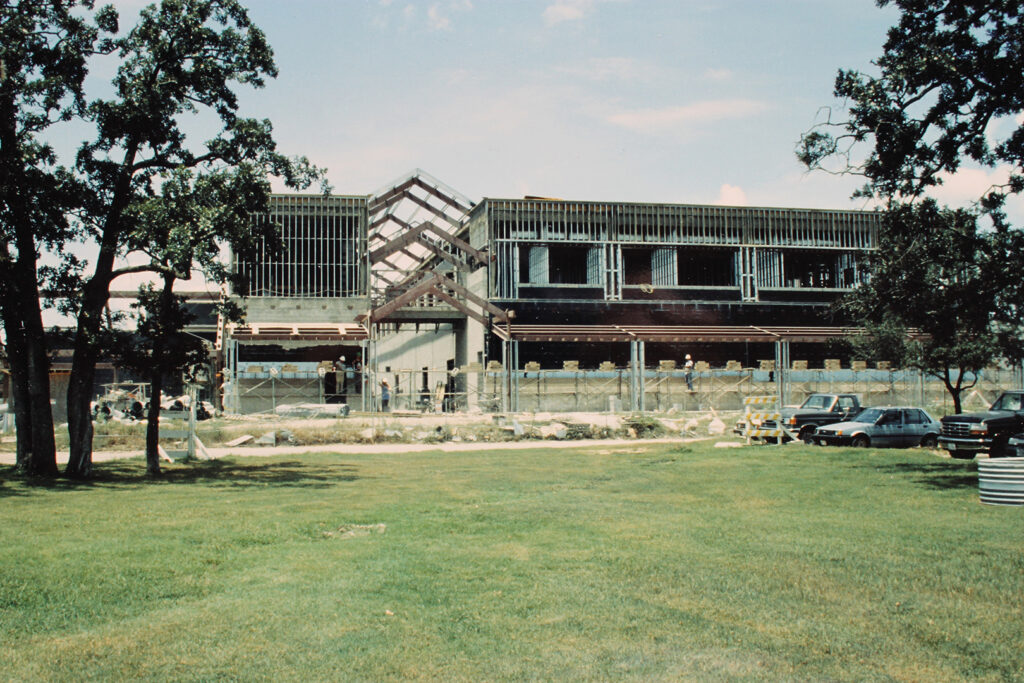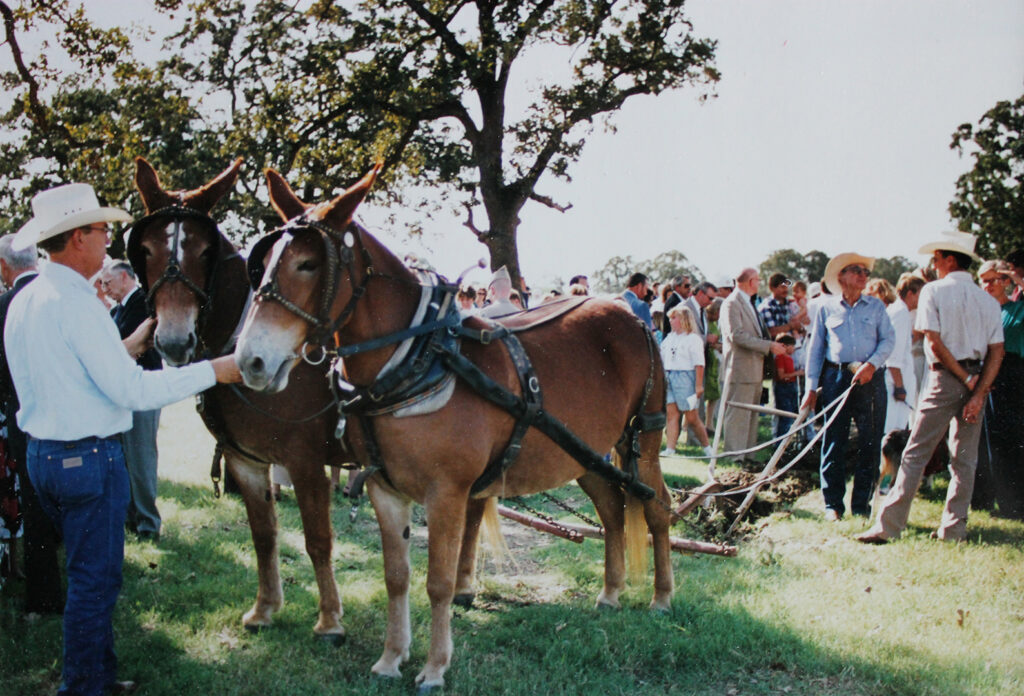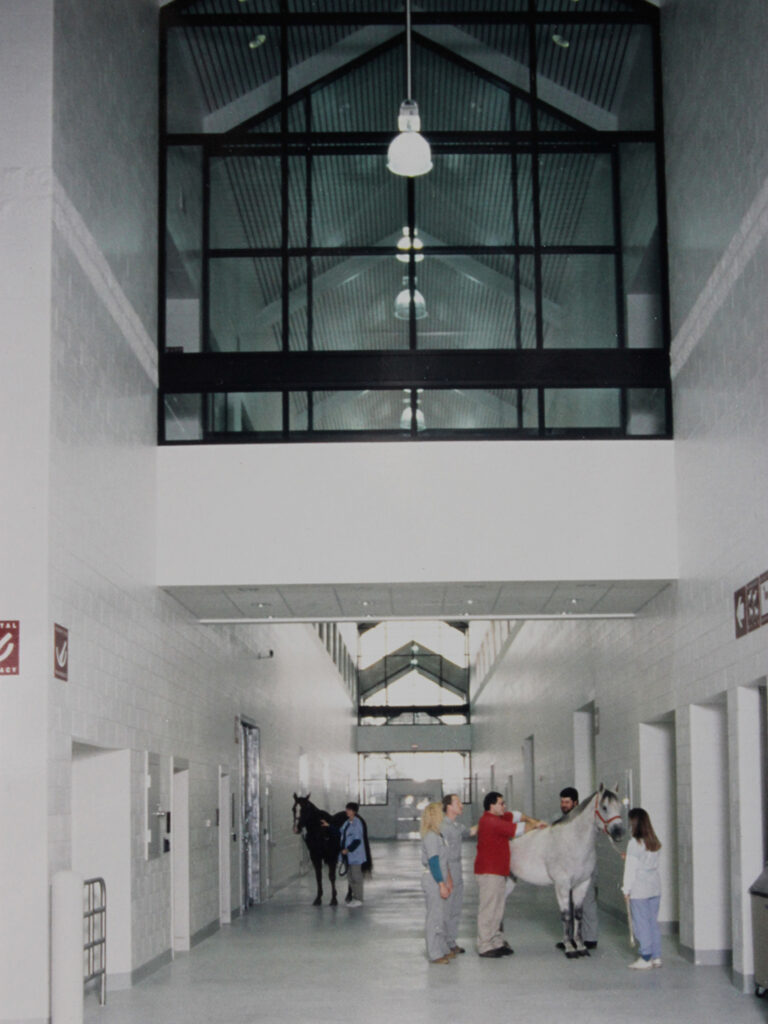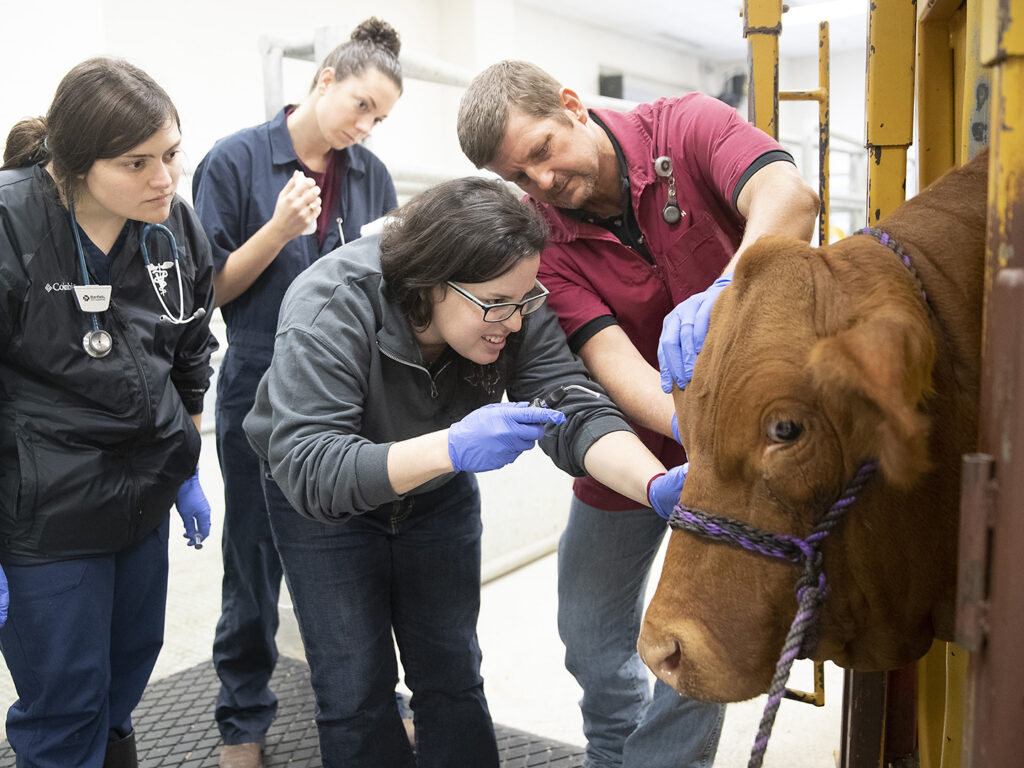Texas A&M Celebrates 30 Years Of Patient Care, Innovation At Large Animal Teaching Hospital Facility
Story by Rachel Knight, VMBS Communications

In December 1888, a small, wood-frame barn was built at Texas A&M University to serve as a veterinary hospital. Ever since that original, 720-square-foot barn served the university’s first veterinary patients, the campus has been home to continuously improving veterinary facilities.
When the School of Veterinary Medicine & Biomedical Sciences (VMBS) was officially established in 1916, it took on the responsibility of running the Veterinary Medical Teaching Hospital facilities. Today, the VMBS is home to the state’s only veterinary teaching hospital consisting of the Large Animal Teaching Hospital (LATH) and the Small Animal Teaching Hospital (SATH).
The current LATH facility, which began serving patients in August 1993, plays an important role in treating horses, cattle, and all other hoofstock with its state-of-the-art design specially built to meet the unique needs of modern large animal veterinary medicine.
This year, the facility celebrates 30 years of housing the exceptional people who provide cutting-edge medicine to large animals throughout Texas and across the United States, as well as veterinary innovation, groundbreaking research, and outstanding education to future Aggie veterinarians.
Exceptional People
Dr. Jennifer Schleining, head of the VMBS’ Large Animal Clinical Sciences (VLCS) department, said that if the LATH’s walls could talk, they’d surely comment on the people who’ve passed through.
“These walls see the students, staff, and faculty who are committed to doing the best we can for every patient that walks in the door and to providing compassionate care at the expert level expected for our patients,” Schleining explained.
Dr. Stacy Eckman, associate dean for hospital operations, echoed Schleining’s enthusiasm for the bright and talented minds who’ve worked within the LATH’s walls.

“Our faculty foster a welcoming environment for all students, and I think that’s a really important part of what happens here,” Eckman said “They are willing to take on the toughest of the tough cases. They’re willing to be innovative. They’re willing to drive the next generation of veterinarians to push themselves to further expand the boundaries of what we can offer here.”
Some of the brightest veterinarians in the world have graced the LATH facilities. This list currently includes Drs. Jeffrey Watkins and Kati Glass, equine orthopedic specialists whose innovative surgeries not only prolong their patients’ lives but also improve their quality of life; Dr. Charles Love, a leading theriogenologist whose research is enhancing horse breeding and whose manuscripts, book chapters, and invited presentations receive international recognition; Dr. Kevin Washburn, a beloved teacher and leader in bovine respiratory disease; Dr. Joanne Hardy, a veterinarian dedicated at all hours of the day and night to providing emergency and critical care service who is also conducting interdisciplinary research; Dr. Jay Griffin, a national expert on imaging of the brain with translation of his research to human cancer patients; and Dr. Noah Cohen, an internationally renowned veterinarian, researcher, and leader in the field of equine health; and many more.
It’s hard to walk through the LATH without feeling a sense of awe, both because of the brilliant veterinarians who work there and because of the layout and design of the building. The building exudes a rare combination of spaciousness, ease, and warmth.
“I think the proximity with which we all interact within the space without being cramped and feeling like we don’t have to compete for resources is one of the special parts, but it is also the pride of being part of something as special as Texas A&M within the walls of this well-built hospital,” Schleining said. “That pride really connects people to want to do good things with each other here.”
Veterinary Innovation

The LATH serves as a reminder of just how far veterinary medicine has come since the university began serving patients out of a small wooden barn 135 years ago.
“Our operating rooms are state-of-the-art, and our flooring system is specially designed and padded to help protect our hoofed patients coming out of surgery,” Eckman said. “Some of our rooms have extra room so that a partner horse can be by a patient’s side to provide support. These are just a few of the special needs our LATH so thoughtfully includes.
“The LATH also includes several design elements inspired by Temple Grandin, an internationally recognized animal behaviorist, to help minimize a patient’s feelings of anxiety or fear as they enter a new or unknown space,” she said.
The facility’s innovative design also encourages collaboration, Schleining shared.
“Even though we have a large space, we fill it with dedicated people who are always conversing and collaborating within the LATH halls, making magic happen,” Schleining said. “We are really blessed to have the space to be able to provide the most advanced compassionate care for large animals and to have a facility designed in a way that encourages people to gather and work through challenges together.
“A recent example of this is Dante, a longhorn steer who came to the Food Animal and Surgery Service in the LATH from the Austin Zoo with a fractured skull,” she continued. “His case started in radiology and ended with an innovative, first-of-its-kind surgery with input from food animal surgeons and medical internists, radiology, orthopedics, anesthesiology, and our equine farrier who was able to fabricate materials for us.”
This kind of collaboration is a daily occurrence at the LATH, which is why clients have traveled from 37 of the 50 United States seeking veterinary care at the facility.
Groundbreaking Research
With innovation comes research, and the LATH helps facilitate research aimed at improving large animal veterinary medicine.
“The world’s best hospitals — like the Mayo Clinic, Johns Hopkins, Mass General, etc. — are places where clinical research is actively advancing biomedical research to improve patient care,” said Cohen, who also serves as the VLCS’ associate department head for research and graduate studies. “The end goal of biomedical research is to improve the health of people and animals. This is ultimately manifested in applying new tests to better identify individuals with disease or at increased risk of disease, improved treatments for patients with disease, and preventatives like vaccines to stop disease from developing. The faculty and staff who work in the LATH conduct this work that enables us to provide cutting-edge care.”
The LATH facilities also add to an environment that promotes observational studies, or research in which patient outcomes are examined overtime.
“The records of our patients can be reviewed in observational studies to help us learn about which interventions work best for patient management, which findings predict better clinical outcomes, and which historical findings or tests best inform diagnosis,” he shared.
Cohen said the research that the LATH facilities help make possible also enhances the student experience and the overall quality of care provided.
“Our students can learn about the impact of translational research in advancing veterinary medicine,” he said. “The collective, team-based approach of the LATH enables us to provide the highest quality care for our patients, including the application of innovations from diagnostic tests, treatments, and preventatives developed at Texas A&M and beyond.”
Outstanding Education

In addition to encouraging innovation and research, the LATH’s architectural design also enhances learning and teaching efforts that take place there by providing more room for visual and hands-on learning.
“In the vast majority of the clinical rotations here, (fourth-year) students get a lot of hands-on experience and are honing skills that they can take forward with them after they graduate,” Schleining explained. “The intentionality of this building helps make that possible.”
Eckman’s was among one of the early Doctor of Veterinary Medicine classes to learn in the current LATH and said it provides a much better learning environment than previous hospital buildings.
“The teaching and learning experiences really benefit from the larger exam rooms,” she said. “The older facilities were much more cramped, which made it harder to see what you were supposed to be learning. That’s certainly not the case now. We have multiple options for safely viewing and learning. For example, in our recovery stalls, when a patient is coming out of anesthesia, we can have students safely watching on the catwalk above.”
A Building Worth Celebrating
The LATH has played an important role in advancing human and animal health by enhancing the veterinary educational experience over the last 30 years. Eckman said she’s excited to celebrate this important milestone.
“Buildings wear down over time, but from a space standpoint and our ability to teach and care for patients in that building, it really hasn’t aged. We still offer state-of-the-art care and continue to offer new and improved treatments in the LATH,” she said. “It’s worth celebrating because this building has withstood the test of time.
“As we look forward to the next 30 years in the LATH, we will continue to have a sense of adventure when taking on challenging cases and thinking outside of the box on how we can improve the life of a patient, whether they are a working animal or a beloved pet.”
###
For more information about the Texas A&M School of Veterinary Medicine & Biomedical Sciences, please visit our website at vetmed.tamu.edu or join us on Facebook, Instagram, and Twitter.
Contact Information: Jennifer Gauntt, Director of VMBS Communications, Texas A&M School of Veterinary Medicine & Biomedical Sciences, jgauntt@cvm.tamu.edu, 979-862-4216


